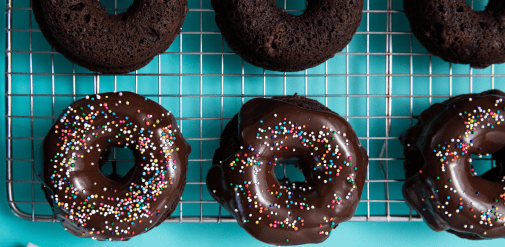Chocolate Overview
When baking something chocolate-y, the quality of the chocolate is not something to be compromised. We have plenty of recipes for you to try that use Divine Chocolate and Divine Cocoa Powder, allowing you to tick the ‘top quality’ box and focus your attention on the actual baking!
You’ll notice that the majority of our recipes use our Bittersweet Baking Bar (70% dark chocolate) and/or our Unsweetened Cocoa Powder. A few others include milk chocolate or white chocolate. Here are some fun facts to help you learn more about baking with chocolate:
1. Cocoa powder consists of the non-fat part of the cacao bean, ground into powder.
2. Dark chocolate has a higher cocoa content and is less sweet than milk and white chocolate.
3. The strong flavor of cocoa lends itself well to creating rich and indulgent chocolate cakes and desserts. The taste is slightly bitter but balances well with sugar and other sweet ingredients.
How To: Store Chocolate
Before you start baking, keep in mind that chocolate can be quite sensitive, especially in relation to temperature. When storing chocolate, there are a few important details to keep in mind. Follow the steps below to keep your chocolate high quality and ready-to-use.
1. Store chocolate at a temperature of around 65 to 70 degrees Fahrenheit. Chocolate, just like us, prefers to be kept in room temperature conditions that's not too hot or too cold.This said, be sure to keep it out of direct sunlight and never put chocolate in the fridge.
2. Store chocolate in a cool, dark place. This could be in cabinets in your kitchen, pantry, or other spaces with no humidity and no direct sunlight.
3. Chocolate doesn't like to sit around unprotected. If you open a chocolate bar and don't eat it all, but sure to wrap it back up in airtight wrapping until you eat the rest of it. The chocolate should remain fresh for many days after it is opened when you follow the above suggestions.
4. Chocolate can sometimes take on the smell or taste of surrounding foods, so be sure to keep chocolate away from pungent foods.
How to: Temper Chocolate
What does it mean to temper chocolate? In short, "tempering" is the method of melting down blocks of solid chocolate to a thick liquid that will be used in many baking recipes. Follow the steps below for tempered chocolate:
1. Get a double boiler or simply place a glass or metal bowl on top of a pot of hot water filled one inch high. Make sure that the bowl is above the water, not resting in it.
2. Of the chocolate you would like to temper, set aside one quarter of it to use later in the process.
3. Place the majority of the chocolate to temper in the bowl and bring the water in the pot to a simmer. Do not let it come to a boil.
4. Bring the chocolate to 118 degrees fahrenheit for dark chocolate and 112 degrees fahrenheit for milk chocolate. Then, remove the bowl and wipe moisture from the bottom with a kitchen towel.
5. To help bring down the temperature of the chocolate, add in the solid chocolate you set aside in step 2 to the bowl of melted chocolate.
6. Stir with a rubber spatula until the chocolate is smooth and reaches a temperature of 89-90 degrees fahrenheit for dark chocolate and 86-88 degrees fahrenheit for milk chocolate.
7. Maintain this temperature by using a bowl of cool water or your double boiler method. The chocolate is now ready to enjoy!
How to: Melt Chocolate
Melting chocolate is straightforward once you know how, but again requires you to be aware of its sensitivity to temperature. Chocolate melts at a low temperature so putting it over a high heat will cause it to ‘seize’ and burn and render it unusable.
To perfectly melt chocolate, follow these easy steps:
1. Break or chop chocolate into even-sized pieces
2. Place in a heatproof bowl and set over a pan of barely simmering water (not boiling).
3. Make sure the water does not touch the bowl. Stir while the chocolate gradually melts.
Milk chocolate and white chocolate melt at a lower temperature than dark chocolate so use caution when melting them.
Baking with Divine Chocolate
Divine Chocolate is the only Fairtrade chocolate company that is co-owned by cocoa farmers in the world. We are proud to offer a line of three baking bars and 100% pure cocoa powder for chocolate lovers around the world. Bake with us to discover the rich, smooth taste of Divine Chocolate.
Our baking bars are all vegan and contain differing levels of sugar so you have complete control of what goes into your body. Baking can be a fun (and messy) feat, and we hope to inspire you to baking with us this Fall with our new 55% and 100% baking bars.
Did You Know: The Difference between each Baking Bar
Divine Chocolate offers three different kinds of baking bars, from 55% to 70% to 100% cocoa. This means that you have the ability to choose how sweet or bitter you'd prefer the chocolate to be in your recipes. The 100% cocoa baking bar has zero grams of sugar and is a great option if you prefer less sweet desserts or want to limit sugar in your diet. The 55% and 70% bars have some sugar added, but as a baker, you always have the option to add in less sugar when experimenting in the kitchen.
Divine Chocolate baking bars have an exquisite melting point that creates smooth and satisfying desserts. The chocolate is made with 100% pure cocoa butter and tastes more delectable and rich than other chocolate brands. The difference between our baking bars is the amount of sugar added, and you have complete control over how sweet and chocolatey you want your dessert to be.
Did You Know: About the Melting and Blooming Point
At one time or another, most of us have had that unfortunate experience of discovering a melted chocolate bar in our handbags, our cars, or our homes. To avoid this, follow the steps above on how to appropriately store chocolate, and read below about how and why this happens.
When the chocolate melts, the sugar starts to seperate from the cocoa butter, creating what's called a "bloom."
There are two kinds of blooming; a sugar bloom and a fat bloom. Sugar blooms occur when condensation reaches the top layer of the chocolate and the sugar separates to form crystals on the top of the bar. Fat blooms are very similar, as it is fat crystallization on the chocolate bar. This is caused by inconsistent and wrong temperatures. Both sugar blooms and fat blooms can be avoided by following the steps on how to store chocolate listed above.






